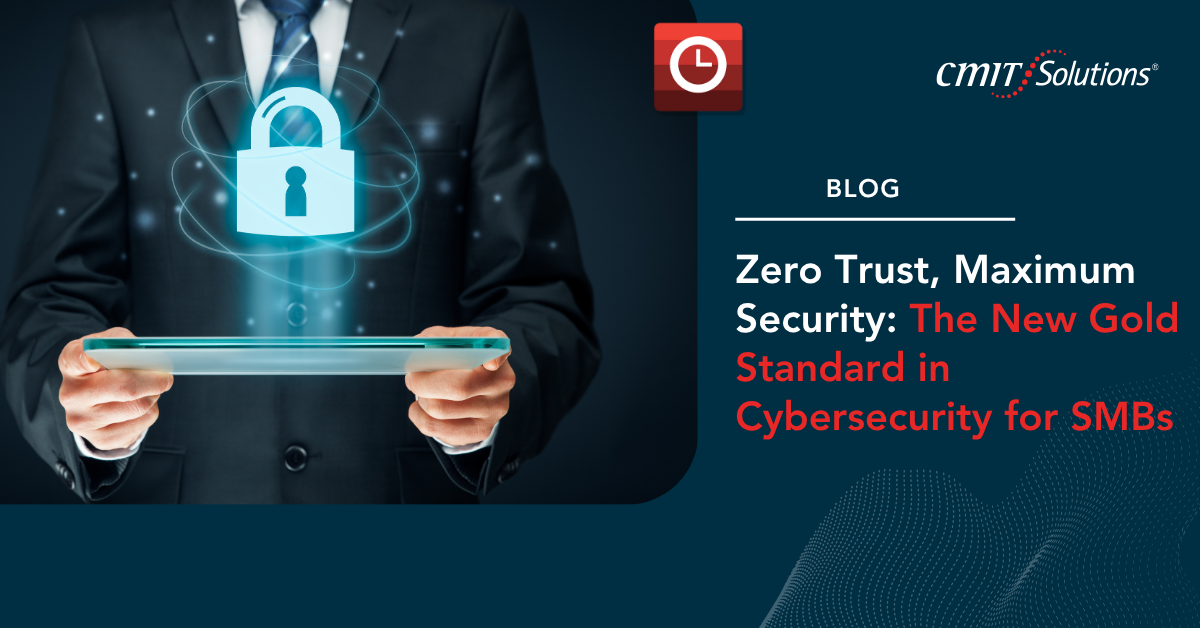Introduction
The digital landscape is no longer what it used to be. In today’s hyper-connected, cloud-first world, traditional perimeter-based security models have proven inadequate. Small and mid-sized businesses (SMBs), often considered “low-hanging fruit” for cybercriminals, face a growing threat from ransomware, phishing, supply chain attacks, and data breaches.
To combat this escalating risk, cybersecurity strategies have undergone a paradigm shift. Enter Zero Trust Security—a philosophy that treats every user, device, and application as potentially compromised until proven otherwise.
For SMBs in Bothell and Renton, the adoption of Zero Trust principles is no longer optional—it’s becoming the new gold standard for security. In this blog, we’ll explore what Zero Trust is, why it’s essential for growing businesses, and how CMIT Solutions of Bothell and Renton helps organizations implement this game-changing approach.
What Is Zero Trust Security?
Zero Trust is a security model based on the principle of “never trust, always verify.” Instead of assuming everything inside a corporate network is safe, Zero Trust requires continuous authentication, least-privilege access, and micro-segmentation of networks.
Key principles include:
- Identity Verification: Every user and device must prove their identity.
- Least Privilege Access: Users get only the access they need—no more, no less.
- Continuous Monitoring: Behavior is tracked and validated in real-time.
- Micro-Segmentation: Data and systems are isolated to minimize lateral movement.
- Assume Breach Mentality: Every part of your infrastructure is monitored as if it’s already compromised.
Why Traditional Security Isn’t Enough
Outdated Perimeters
Legacy IT security often relies on a firewall perimeter—assuming everything inside is trusted. But with remote work, BYOD (Bring Your Own Device) culture, and cloud infrastructure, the perimeter is gone.
Email Threats
Email remains the top vector for cyberattacks. According to recent reports, 91% of cyberattacks start with a phishing email. That’s why email security is one of the first layers businesses should harden within a Zero Trust framework.
Endpoint Vulnerabilities
As endpoints proliferate—from laptops to mobile phones—attackers target these weak links. Investing in advanced EDR (Endpoint Detection and Response) is no longer a luxury but a necessity for SMBs.
Why SMBs Must Embrace Zero Trust Now
SMBs Are Big Targets
Cybercriminals know SMBs often lack enterprise-level defenses. That’s why ransomware gangs increasingly focus on smaller companies, knowing they are more likely to pay to recover data.
Compliance Requirements
Whether you’re in healthcare, finance, or e-commerce, regulations like HIPAA, PCI-DSS, and GDPR require stricter security controls. A compliance-first IT partner helps align Zero Trust practices with your audit requirements.
Secure Growth and Remote Work
With hybrid teams and cloud-native workflows becoming the norm, Zero Trust is the only model that secures every touchpoint. Unified communications strategies and remote access tools must be secured with continuous verification protocols.
Core Components of a Zero Trust Architecture for SMBs
1. Identity and Access Management (IAM)
Implementing strong IAM policies ensures that only authorized users access critical resources. This includes single sign-on (SSO), multi-factor authentication (MFA), and role-based access control.
2. Device Verification
Zero Trust requires that each device be checked for compliance and security posture. Microsoft Intune and Mobile Device Management (MDM) can help automate this process for SMBs.
3. Data Encryption and Micro-Segmentation
All data—at rest and in transit—should be encrypted. Networks should be broken into segments to prevent lateral movement in the event of a breach.
4. Continuous Monitoring and SIEM Tools
Security Information and Event Management (SIEM) tools like Microsoft Sentinel offer real-time visibility into threats. Learn how SIEM tools help SMBs detect and respond to incidents fast.
5. Cloud Security
Securing your cloud environment is non-negotiable. From SaaS platforms to virtual desktops, Zero Trust policies extend to every service you use. Learn how cloud-first businesses in Bothell are improving both security and flexibility.
Implementing Zero Trust with CMIT Solutions of Bothell and Renton
As a managed IT services provider, CMIT Solutions of Bothell and Renton offers end-to-end Zero Trust security implementation. Here’s how they help:
A. Risk Assessment & Baseline Audits
Before building a Zero Trust model, CMIT conducts a comprehensive audit of your current systems, identifying vulnerabilities and mapping user roles.
B. Security Stack Implementation
From SIEM to EDR to IAM, CMIT deploys the tools necessary to enforce Zero Trust policies across your business. Their multi-layered security ensures your business is protected at every level.
C. Disaster Recovery and Business Continuity
In a Zero Trust world, having a reliable backup and recovery strategy is essential. CMIT helps businesses build reliable disaster recovery plans that align with Zero Trust assumptions of inevitable breach.
D. Continuous Training and Compliance
Security is only as strong as your weakest user. CMIT provides training for your staff and ensures ongoing alignment with compliance regulations like HIPAA and PCI-DSS. This is especially vital for industries like healthcare IT.
The Strategic Business Case for Zero Trust
Drives Long-Term Efficiency
Adopting Zero Trust simplifies security management and reduces long-term IT costs. You’re no longer firefighting breaches—you’re preventing them.
Explore how this approach fits into a strategic managed services model for small businesses.
Enables Innovation
Zero Trust allows you to explore new technologies like AI, cloud analytics, and unified communications without increasing risk. This proactive stance empowers your business to innovate without hesitation.
Future-Proofs Your Infrastructure
As regulations tighten and threats evolve, Zero Trust provides a flexible and adaptive framework. With insights from events like Microsoft Ignite, CMIT keeps your systems one step ahead of emerging risks.
Common Myths About Zero Trust—Debunked
Myth 1: It’s only for large enterprises.
Reality: SMBs are often more vulnerable and less equipped to recover from attacks. Zero Trust levels the playing field.
Myth 2: It’s too expensive or complex.
Reality: With a partner like CMIT, Zero Trust is implemented incrementally and affordably, using cloud-native tools.
Myth 3: It slows down operations.
Reality: Modern IAM and automation make Zero Trust seamless for users, improving productivity and reducing downtime.
Final Thoughts: Zero Trust Is a Must-Have, Not a Nice-to-Have
In today’s threat landscape, Zero Trust isn’t a futuristic concept—it’s the foundation of modern cybersecurity. SMBs that adopt this model are not just defending against today’s threats—they’re positioning themselves for secure, scalable success.
With CMIT Solutions of Bothell and Renton as your IT partner, you don’t need a massive budget or internal cybersecurity team to embrace Zero Trust. You need a proactive strategy, the right tools, and a commitment to maximum security.
Want to get started? Connect with CMIT Solutions of Bothell and Renton and let their team tailor a Zero Trust roadmap for your business today.






